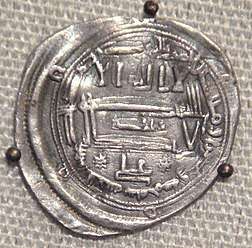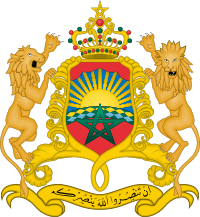Idrisid dynasty
The Idrisids (Arabic: الأدارسة al-Adārisah) were a Moroccan Muslim dynasty of Morocco, ruling from 788 to 974. Named after the founder Idriss I, the great grandchild of Hasan ibn Ali, the Idrisids are considered to be the founders of the first Moroccan state.
Idrisid dynasty الأدارسة | |||||||||||
|---|---|---|---|---|---|---|---|---|---|---|---|
| 788–974 | |||||||||||
_(1258_1659).svg.png) Flag | |||||||||||
Idrisid state, around 820 CE, showing its maximal extent. | |||||||||||
| Status | Ruling dynasty of Morocco | ||||||||||
| Capital | Walilli (788–808) Fez (808–927) Hajar an-Nasar (927–985) | ||||||||||
| Common languages | Arabic, Berber languages | ||||||||||
| Religion | Muslim | ||||||||||
| Government | Monarchy | ||||||||||
| Historical era | Medieval | ||||||||||
• Established | 788 | ||||||||||
• Disestablished | 974 | ||||||||||
| |||||||||||
Part of a series on the |
|---|
| History of Morocco |
 |
|
|
Related topics
|
|
|
Religion
Primary source material and contemporary scholars have described them as a Sunni Muslim dynasty.[1][2][3] Certain contemporary academics have described them as Zaydi-Shia[4] most likely because of their political affiliation. Others have criticized this claim for conflating Shia theology with a political movement in a historical period where there was no Shia theology distinct from Sunni theology in existence yet.[5] The Idrisids were political opponents of the Abbasid Caliphate.[6]
History
The founder of the dynasty was Idris ibn Abdallah (788–791),[7] who traced his ancestry back to Ali ibn Abi Talib[7] and his wife Fatimah, daughter of the Islamic prophet, Muhammad. After the Battle of Fakhkh, near Mecca, between the Abbasids and supporters of the descendants of the prophet Muhammad, Idris ibn Abdallah fled to the Maghreb. He first arrived in Tangier, the most important city of Morocco at the time, and by 788 he had settled in Volubilis.
The powerful Awraba Berbers of Volubilis (or Walili as the Berbers called it) took him in and made him their 'imam' (religious leader). The Awraba tribe had supported Kusayla in his struggle against the Ummayad armies in the 670s and 680s. By the second half of the 8th century they had settled in northern Morocco, where their leader Ishak had his base in the Roman town of Volubilis. By this time the Awraba were already Muslim, but lived in an area where most tribes were either Christian, Jewish, Khariji or pagan. The Awraba seem to have welcomed a Sharifi imam as a way to strengthen their political position. Idris I, who was very active in the political organization of the Awraba, began by asserting his authority and working toward the subjugation of the Christian and Jewish tribes. In 789 he founded a settlement south east of Volubilis, called Medinat Fas. In 791 Idris I was poisoned and killed by an Abbasid agent. Even though he left no male heir, shortly after his death, his wife Lalla Kanza bint Uqba al-Awrabi, bore him his only son and successor, Idris II. Idris' loyal Arab ex-slave and companion Rashid brought up the boy and took on himself the regency of the state, on behalf of the Awraba. In 801 Rashid was killed by the Abbasids. In the following year, at the age of 11 years, Idris II was proclaimed imam by the Awraba.
Even though he had spread his authority across much of northern Morocco, as far west as Tlemcen, Idris I had been completely dependent on the Awraba leadership. Idris II began his rule with the weakening of Awraba power by welcoming Arab settlers in Walili and by appointing two Arabs as his vizier and qadi. Thus he transformed himself from a protégé of the Awraba into their sovereign. The Awraba leader Ishak responded by plotting against his life with the Aghlabids of Tunisia. Idris reacted by having his former protector Ishak killed, and in 809 moved his seat of government from the Awraba dominated Walili to Fes, where he founded a new settlement named Al-'Aliya. Idriss II (791–828) developed the city of Fez, established earlier by his father as a Berber market town. Here he welcomed two waves of Arab immigration: one in 818 from Cordoba and another in 824 from Aghlabid Tunisia, giving Fes a more Arab character than other Maghrebi cities. When Idris II died in 828, the Idrisid state spanned from western Algeria to the Sous in southern Morocco and had become the leading state of Morocco, ahead of the principalities of Sijilmasa, Barghawata and Nekor.
The dynasty would decline following Idriss II's death and under his son and successor Muhammad (828–836) the kingdom was divided amongst seven of his brothers, whereby eight Idrisid statelets formed in Morocco and Algeria.[8] Muhammad himself came to rule Fes, with only nominal power over his brothers. During this time Islamic and Arabic culture gained a stronghold in the towns and Morocco profited from the trans-Saharan trade, which came to be dominated by Muslim (mostly Berber) traders.

Even so, the Islamic and Arabic culture only made its influence felt in the towns, with the vast majority of Morocco's population still using the Berber languages and often adhering to Islamic heterodox and heretical doctrines. The Idrisids were principally rulers of the towns and had little power over the majority of the country's population. The Idrisid family in turn was heavily berberised, with its members aligning itself with the Zenata tribes of Morocco. Already in the 870s the family was described by Ibn Qutaybah as being berberised in customs. By the 11th century this process had developed to such an extent, that the family was fully integrated in the Berber societies of Morocco. In the 11th century the Hammudid family arose among these Berber Idrisids, which was able to gain power in several cities of northern Morocco and southern Spain.

| Historical Arab states and dynasties | ||||||||||||||||||||||||||||||||||||||||||||||||||||||||||
|---|---|---|---|---|---|---|---|---|---|---|---|---|---|---|---|---|---|---|---|---|---|---|---|---|---|---|---|---|---|---|---|---|---|---|---|---|---|---|---|---|---|---|---|---|---|---|---|---|---|---|---|---|---|---|---|---|---|---|
 | ||||||||||||||||||||||||||||||||||||||||||||||||||||||||||
|
Ancient Arab States
|
||||||||||||||||||||||||||||||||||||||||||||||||||||||||||
|
Arab Empires
|
||||||||||||||||||||||||||||||||||||||||||||||||||||||||||
|
Eastern Dynasties
|
||||||||||||||||||||||||||||||||||||||||||||||||||||||||||
|
Western Dynasties
|
||||||||||||||||||||||||||||||||||||||||||||||||||||||||||
|
Arabian Peninsula
|
||||||||||||||||||||||||||||||||||||||||||||||||||||||||||
|
East Africa
|
||||||||||||||||||||||||||||||||||||||||||||||||||||||||||
|
Current monarchies
|
||||||||||||||||||||||||||||||||||||||||||||||||||||||||||
In 868 the Berber Khariji tribes of Madyuna, Ghayata and Miknasa of the Fes region formed a common front against the Idrisids. From their base in Sefrou they were able to defeat and kill the Idrisid Ali ibn Umar and occupy Fes. His brother Yahya was able to retake the city in 880 and establish himself as the new ruler. The Idrisids attacked the Kharijis of Barghawata and Sijilmasa, and the Sunnis of Nekor multiple times, but were never able to include these territories in their state.
In 917 the Miknasa and its leader Masala ibn Habus, acting on behalf of their Fatimid allies, attacked Fes and forced Yahya ibn Idris to recognize Fatimid suzerainty, before deposing him in 921. Hassan I al-Hajam managed to wrest control of Fez from 925 until 927 but he was the last of the dynasty to hold power there. From Fes, the Miknasa began a violent hunt across Morocco for members of the Idrisid family, seeking to exterminate them. Most of the Idrisids settled among the Jbala tribes in North-west Morocco where they were protected by the reluctance of tribal elders to have the local descendants of Muhammad's family be wiped out. In the Jbala region they had a stronghold in the fortress of Hajar an-Nasar, from where they tried to restore their power base, until the last Idrisid made the mistake of switching allegiances back to the Fatimids, and was deposed and executed in 985 by the Cordobans.
The dynasty
Rulers
- Idris I – (788–791)
- Idris II – (791–828)
- Muhammad ibn Idris – (828–836)
- Ali (I) ibn Muhammad – (836–848)
- Yahya (I) ibn Muhammad – (848–864)
- Yahya (II) ibn Yahya – (864–874)
- Ali (II) ibn Umar – (874–883)
- Yahya (III) ibn al-Qasim – (883–904)
- Yahya (IV) ibn Idris – (904–917)
- Fatimid overlordship – (917–925)
- Al-Hajjam al-Hasan ibn Muhammad ibn al-Qasim – (925–927)
- Al-Qasim Guennoun – (937-948)
- Abul-Aish Ahmad – (948-954)
- Al-Hasan (II) ibn Guennoun – (954–974) (not to be confused with Hassan II of Morocco, born in 1929)
Timeline

Offshoots
- Hammudid dynasty in al-Andalus – (1016–1058)
- Idrisids of Morocco (Joutey branch) – (1465–1471)
- Banu Rachid of Chefchaouen (Alami branch) – (1471–1561)
- Idrisid emirs of Asir – (1906–1934)
- Senussi dynasty of Libya – (1918–1969)
— Royal house — Idrisid dynasty | ||
| Preceded by — |
Emirs of Morocco 789–917 925–927 937–974 |
Succeeded by — Umayyad overlordship |
| Preceded by Umayyad dynasty |
Caliphs of Cordoba Hammudid branch 1016–1023 1025–1027 |
Succeeded by Umayyad dynasty (Restored) |
| Preceded by — Disintegration of the Caliphate of Cordoba |
Taifa kings of Malaga Hammudid branch 1026–1057 |
Succeeded by — Annexed to the Taifa of Granada |
| Preceded by — Disintegration of the Caliphate of Cordoba |
Taifa kings of Algeciras Hammudid branch 1039–1058 |
Succeeded by — Annexed to the Taifa of Seville |
| Preceded by Marinid dynasty |
Sultans of Morocco Joutey branch 1465–1472 |
Succeeded by Wattasid dynasty |
See also
- Idriss El-Kamil Ibn Yunas Aberkane
- Hammudid dynasty
- Kingdom of Libya
- Muhammad al-Idrisi, descendant of the Idrisid dynasty
- History of Algeria
- History of Morocco
- List of Shi'a Muslim dynasties
Notes and references
- A History of the Maghrib in the Islamic Period, (J. Abun-Nasr, 1987), p.50
- Al-Bayan Al-Maghreb (Ibn Idhari al-Marrakushi, 13th century), Vol.1, p.118 (Arabic - Dr. Bashar A. Marouf & Mahmoud B. Awad, 2013)
- Tarikh al-Tabari (Al-Tabari, 9th century) – English translation: The History of al-Tabari vol.26, p.37-38
- Meis Al-Kaisi, "The Development of Politico-Religious Movements: A General Overview", Arabic Heritage in the Post-Abbasid Period, ed. Imed Nsiri, (Cambridge Scholars Publishing, 2019), 124.
Ludwig W. Adamec, The Historical Dictionary of Islam, page 145, "Idrisid Dynasty (788-985). First Shi'ite dynasty in Islamic history, founded by Idris ibn Abdullah....".
C.E. BosworthThe New Islamic Dynasties, page 25, "The Idrisids were the first dynasty who attempted to introduce the doctrines of Shi'ism, albeit in a very attenuated form, into the Maghrib...".
Ignác Goldziher and Bernard Lewis, Introduction to Islamic theology and law, Princeton University Press (1981), p. 218
Mara A. Leichtman, Shi'i Cosmopolitanisms in Africa: Lebanese Migration and Religious Conversion in Senegal, page 216;"Senegalese Shi'a also refer to the spread of Shi'i Islam to Senegal through the Idrisid dynasty and evidence of Shi'i roots in Morocco through 'Alaouis (Hydarah 2008:132-135). Cornell writes that Moulay Idris and his successors, descendants of the Prophet's grandson Hasan, brought with them to Morocco from the Arabian Peninsula "a form of archaic Shi'ism that was similar in many respects to Zaydism" (1998:200)." - De Geschiedenis van Marokko & Noord-Afrika (Sofyan al Kandoussi, 2019), p.179 (Dutch history book on Morocco and North-Africa)
- Hillenbrand, Carole, ed. (1989). The History of al-Ṭabarī, Volume XXVI: The Waning of the Umayyad Caliphate: Prelude to Revolution, A.D. 738–744/A.H. 121–126. SUNY Series in Near Eastern Studies. Albany, New York: State University of New York Press. pp. 37–38. ISBN 978-0-88706-810-2.
- Idris I, D. Eustache, The Encyclopaedia of Islam, Vol. III, ed. B.Lewis, V. L. Menage, C. Pellat and J. Schact, (Brill, 1986), 1031.
- Idrisids, D. Eustache, The Encyclopaedia of Islam, Vol. III, 1035.
Sources
- Ibn Abi Zar, Rawd al-Qirtas (contains a chronicle of the dynasty).
- Charles-André Julien, Histoire de l'Afrique du Nord, des origines à 1830, Payot 1994.
| Wikimedia Commons has media related to Idrisid dynasty. |
